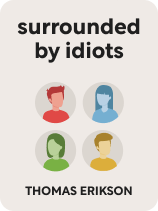

This article is an excerpt from the Shortform book guide to "Surrounded by Idiots" by Thomas Erikson. Shortform has the world's best summaries and analyses of books you should be reading.
Like this article? Sign up for a free trial here .
Have you taken a personality test (whether it be the color model, DISC, or Myers-Briggs)? Which personalities do you match up best with? Which personality types should you avoid?
Probably the three most common personality tests are Myers-Briggs, DISC, and Thomas Erikson’s color model. While matching personalities isn’t an exact science, there are certain pairs that tend to match up well—and others that tend to end in disaster.
Here, we’ll go over the personality pairings from the top three personality models.
The Color Pairings
Erikson says in a perfect world, every working scenario would include all four personality types. He explains that the Yellow personality would come up with the project idea, the Red type would make the decisions and delegate tasks, the Green personality would execute the plan, and the Blue would supervise for quality control. Unfortunately, it’s rare for the color distribution to be so even. For this reason, Erikson says it’s important to find matching personalities that work best together. If you’re in a leadership role, this information will help you formulate your teams. As an employee, it will help you recognize who you would best partner with.
(Shortform note: Which ingredients are needed for a successful collaboration? In addition to complementary working styles, some say the most compatible teams have shared values and motivations. In The 7 Habits of Highly Effective People, Stephen Covey says that great collaborators practice empathic listening, which involves trying to understand the other person’s perspective before asking them to understand yours.)
Four Harmonious Pairings
The best color pairings, according to Erikson, are Red-Blue, Green-Yellow, Blue-Green, and Red-Yellow.
Red-Blue
According to Erikson, Red and Blue personalities are one of the best pairings because they’re both task-oriented and have opposite strengths. Neither is talkative, so they won’t spend too much time socializing and will instead get the job done. He points out that Red types are big-picture thinkers and Blue types like to dive into the details, so they each handle what the other doesn’t enjoy. He warns that the Red-dominant person will have to encourage the Blue to keep up the pace, but because they’re focused on different things, this shouldn’t cause too much of an issue. Blue personalities like to point out problems, and Reds live to solve problems. For all of these reasons, Erikson says the two are an excellent working match.
Green-Yellow
Green and Yellow personality types work well together because they’re opposite in nature but each provides what the other needs, Erikson says. Yellow personalities like to come up with ideas but aren’t great with follow-through, while Green types prefer to be given directions. This is perfect, Erikson says, because the Green-dominant person will happily carry out the Yellow’s plan. Yellow personalities love to talk and Green personalities are excellent listeners. Erikson explains that Greens are a grounding force for the frenetic Yellow types, and the Yellow’s energy helps pull Green types out of their complacency. Even though Yellow-dominant people work quickly and Green personalities are slower, this won’t cause friction because they both care about what others think, so they’ll be considerate of one another.
Blue-Green
Erikson says Blue and Green personalities work well together because they both move at a gentle pace and think things through before acting. He warns that this pairing could be a problem for other people who are waiting on them to complete a project, as it won’t be arriving in any hurry. However, the two of them won’t rush each other. He points out that Green and Blue personality types are also both introverts, so neither one will drain the other’s energy through constant chatter.
Red-Yellow
Red and Yellow personalities are both action-driven, a quality that Erikson says makes them a good match. When they work together, things get done quickly. The Yellow-dominant person will likely come up with the idea and the Red will make all of the decisions and plan the attack. Without the careful eye of a Blue or Green type, Erikson warns that the quality of work might suffer, but the results will be immediate, and both Red and Yellow personalities will be happy with them. Erikson adds that both are clear communicators, so misunderstandings and hurt feelings will be infrequent.
Two Pairings That Rarely Work
According to Erikson, these color combinations aren’t necessarily doomed, but they do present challenges. If you find yourself in one of these difficult pairings, Erikson recommends that you practice self-awareness and predict the obstacles ahead of time.
Red-Green
Erikson asserts that Red and Green personalities have opposite working styles that don’t complement each other. The problems start with the pace; the Red-dominant person will want to get started right away, while the Green will procrastinate. Red types move at lightning speed, and Green personalities take their time. Erikson says this in itself will cause daily disagreements. He points out that Green types are often intimidated by Reds’ direct communication, so they won’t speak up if something is bothering them, leading to resentment and passive-aggressive communication—something that Red personalities despise. Erikson says the saving grace in this color pairing is that Red-dominant people like to give orders and Greens are happy to follow commands.
Yellow-Blue
Erikson says that a Yellow and Blue combination is the most difficult pairing to navigate. He explains that Yellow personalities like to dive into projects and work quickly, never stopping to read directions (so to speak). In contrast, Blue personalities take their time and plan, plan, plan long before they act. He says this disagreement about when to start, what to pay attention to, and how fast to work will produce constant friction.
Erikson points out that Yellow-dominant people can talk all day; Blue types prefer quiet and aren’t great listeners, so they’re likely to grow irritated with their partner’s verbosity. Similarly, the Blue type’s silent working style will lead the Yellow-dominant person to believe he’s devoid of personality or cold-hearted. Erikson reminds us that both of these personality types intensify when they’re stressed, so when they inevitably butt heads, the Yellow-dominant partner will amp up the energy, and the Blue will become more standoffish—compounding all of the original stressors and creating a vicious cycle.
Every DISC Pairing and How They Work Together
Erikson highlights the pairings that he thinks are the best and worst, but he doesn’t acknowledge all of the possibilities. In the DISC model, there are 10 possible unique combination. Here is how they are likely to interact in a work environment.
| Pairing | What Might Happen |
| Dominant-Dominant | This pairing has a high likelihood of conflict because both people will want to be in charge. If two dominant personalities must work together, establish objectives from the start and designate to each person an area of control. |
| Dominant-Inspiring | This is generally a good pairing because the two have similar communication styles but complementary interests. The Dominant personality will focus on results while the Inspiring personality will focus on relationships. |
| Dominant-Stable | This pairing can be successful because the Dominant personality likes to lead and the Stable personality likes to follow. |
| Dominant-Compliant | This is considered one of the best pairings in the DISC model because the two have opposite strengths that complement one another. A friendship is unlikely to form, but the professional relationship will thrive, as the Dominant personality will lead the charge and think big-picture, while the Compliant personality will ensure quality control. |
| Inspiring-Inspiring | Two Inspiring personalities are likely to form a strong friendship, but it isn’t the greatest working combination. The two are likely to get sidetracked, or bite off more than they chew due to their passionate personalities. |
| Inspiring-Stable | This is generally a good combination, as both are relationship-focused and will be considerate of one another. The Stable personality will help keep the Inspiring personality on track, while the Inspiring personality will draw the Stable personality out of his routine. |
| Inspiring-Compliant | While not impossible, this personality pairing is problematic. The Inspiring personality’s bubbly nature is likely to annoy and overwhelm the Compliant personality. |
| Stable-Stable | Two Stable personalities will work very well together, but because of their slow pace, they’ll likely need someone to hold them accountable. |
| Stable-Compliant | This is a good working relationship, but because the Stable personality cares about feelings and relationships, and the Compliant personality doesn’t, there is a chance some misunderstandings and hurt feelings will arise. |
| Compliant-Compliant | This is a tricky pairing because both people shy away from conflict and are perfectionists. There’s likely to be an undercurrent of competition and passive-aggressive behavior. |
The 8 Best Myers-Briggs Pairings
In the Myers-Briggs model, there are 16 personality types, which can produce 136 unique pairings. In a collaborative setting, the following eight combinations are considered the best.
| ISTJ + ESTP ISTJs are analytical problem-solvers who thrive behind the scenes. ESTPs are also analytic but have great people skills and will energize the partnership. | ISFP + ESFP ISFPs are nurturers who care deeply about the happiness of everyone around them. ESFPs are resourceful and enjoy using their innovation to help others. |
| INTP + INTJ Both of these personalities have a passion for detailed, technical work. INTPs are very curious and innovative, and INTJs are decisive and good at implementation. | ENTP + ENFJ Both of these personalities enjoy collaboration and are excellent communicators. ENTPs are natural leaders and ENFJs bring passion and charisma. |
| ENFP + INFJ ENFPs and INFJs are both caring individuals who do well in service fields and want to make a difference. ENFPs are more outgoing and forge strong relationships, and INFJs are great at reading people. | ISFJ + INFP ISFJs and INFPs are both warm and caring introverts. ISFJs are skilled with detail-oriented work and INFPs are creative with strong communication skills. |
| ENTJ + ISTP ENTJs and ISTPs are both hyper-logical. ENTJs are comfortable taking the lead and ISTPs thrive when working within a set structure. | ESFJ + ESTJ These personalities are very similar but differ in the thinking/feeling component. Where the ESFJ is more relational, the ESTJ balances with a logical approach to everything. |
When in doubt, Erikson says to “act” Green. He reminds us that only 5% of the population is only one personality type, 80% are two, and the remaining 15% are three. When someone is a combination of three types, he says it can be hard to pinpoint what their working style is going to be—it will change depending on the situation. If you find yourself working with a tri-color, he suggests you behave as a Green would: listen, observe, assess, then act. It should become clear after a bit of time which direction they have chosen to lean in and how you can best adapt.
(Shortform note: There is a chance that your partner is sizing you up as well, and this can create a standstill when getting started. Clear communication is the best way to avoid misunderstandings, so it’s a good idea to lay out from the beginning where your strengths and interests lie, and explain your working style.)

———End of Preview———
Like what you just read? Read the rest of the world's best book summary and analysis of Thomas Erikson's "Surrounded by Idiots" at Shortform .
Here's what you'll find in our full Surrounded by Idiots summary :
- A detailed look at Thomas Erikson's four personality types
- How to navigate conflicts with coworkers
- How to effectively communicate and collaborate with bosses, employees, and colleagues







Hello, I hope you are doing well!
I found your site (shortform.com) from SERP and found it really awesome! I wanted to know if you accept paid content in the form of guest posts and give a do-follow link to our client’s site.
Can you please let me know the best minimum price for each normal guest post?
Also, I might be interested to place an in-content text link (Link from already published post)Please let me know the best minimum price if you sell them.
I’m looking for long-term collaboration, so please let us know the prices.
Looking forward to hearing from you soon.
Regards,
Clara
Outreach Manager
Hi Clara,
Thank you for your interest in guest blogging for Shortform. All the information for guest blogging can be found here: https://www.shortform.com/blog/write-for-us/